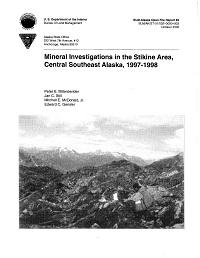Mineral Investigations in the Stikine Area, Central Southeast Alaska, 1997-98

The U.S. Department of the Interior, Bureau of Land Management (BLM) is conducting a 4-year mineral resource assessment of the Stikine area in central Southeast Alaska that began in 1997. The 5.7 million-acre study area encompasses the mainland bordering Frederick Sound and Kupreanof, Kuiu, Zarembo, Wrangell, Etolin, and nearby islands. The study area covers the Stikine Mining District and additional lands not included in adjacent mining district studies. As the main land manager in the area, the U.S. Department of Agriculture, Forest Service, requested that the BLM assess the mineral potential in the Stikine area for the purpose of generating information that will aid the agency in future judgments regarding land management.
This report details information gathered during the 1997 and 1998 field seasons. Subsequent reports will include results from the years 1999 and 2000. Descriptions and assessments of over 90 mines, prospects, and anomalous mineral occurrences are included herein.
The Stikine area hosts a variety of mineral deposit types, including volcanogenic massive sulfide (VMS), replacement, polymetallic vein, vein gold, skarn, porphyry molybdenum, magmatic segregation, and veins of barite. In addition, there are minor deposits of placer gold, uranium, and coal. The Castle Island Mine produced 787,000 tons of barite between 1966 and 1980 (Carnes, 1980). Minor gold production came from the Maid of Mexico (Chapin, 1918) and Helen S (Wright and Wright, 1908) mines in the early part of the twentieth century, and from the Cascade Mine in 1948 (U.S. Bureau of Mines, Mine Production Records).
The Duncan Canal-Zarembo Island-Etolin Island, Groundhog Basin, and Cornwallis Peninsula areas have the most significant mineral potential in the study area. There are 18 sites with known or suspected VMS mineralization along Duncan Canal, and on Woewodski and Zarembo islands. These occurrences share Triassic host rocks of the Alexander terrane with deposits of known significance to the north, the Greens Creek Mine on Admiralty Island and the massive Windy Craggy deposit in northwestern British Columbia.
Thirteen prospects containing replacement and polymetallic vein mineralization occur in the Groundhog Basin area on the mainland near Wrangell. There is also some potential in that area for porphyry molybdenum deposits, in addition to the zones of silver, lead, and zinc that have encouraged significant exploration over the years.
The Cornwallis Peninsula, on the northern end of Kuiu Island, is host to several small deposits of barite and witherite, and there are two well-known deposits of lead and zinc. As presently understood, these occurrences are small and discontinuous, but share the same Triassic Alexander terrane host rocks as the VMS deposits in the area.
